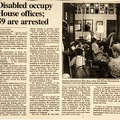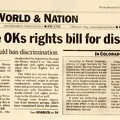METRO Magazine March/April 1991
This article is on 568, 555,551 and 547 and is included here in its entirety for ease of reading.
Disabilities Act Forces Sweeping Transit Changes
Public, private operators must comply with new ADA law.
Uncle Sam hustles to fine tune countless provisions.
By Lenny Levine
The Americans with Disabilities Act (ADA) will force sweeping changes on the transit industry, both public and private, and the battle to implement it is just being joined.
When President Bush signed ADA into law last July shortly after overwhelming approval by Congress, it was the culmination of a decade-long struggle by advocates for the 43 million handicapped Americans and others to provide equal access for the disabled. The law affects transit buses, passenger trains, motorcoaches, stations and how the people who run them do business. Much is known about the law. Indeed, many in transit have long anticipated its provisions and made pieces of their operations “accessible,” the operative word. More, however, is not known. A slew of federal agencies is tuning the law. The name of the tune will unfold with time.
What is known is this: Public agencies must make accessible all new vehicles purchased after last Aug. 25. Transit systems buying used vehicles must demonstrate “a good faith effort" to get accessible vehicles. Agencies that remanufacture vehicles to extend their life at least five years must make them accessible. All criteria, much of which has yet to be spelled out, must be implemented regardless of cost. All that also applies to private operators contracting with public agencies. There is some wiggle room, however. Waivers may be obtained in certain cases. That, too, will be spelled out as ADA is further refined.
Motorcoach operators have more wiggle room, years of it. ADA says small private operators have six years after enactment of the law to become accessible, large operators, seven. But there begins the bureaucratic snafu. “What ‘small’ and ‘large’ mean haven't even been defined for us yet," said Steve Sprague, vice president for governmental affairs of the United Bus Owners of America (UBOA). He said “large” will probably be defined as Interstate Commerce Commission Class I operators. But the definition is a long way off.
That definition — and countless other details that will govern the motorcoach industry —— will come from an old friend of bus folk. It is, ta da: THE STUDY.
”The study was mandated by ADA to govern the motorcoach industry. It is to be conducted by a broad-based committee of government, industry and technical people and advocates for the disabled over three years. Then the secretary of transportation reviews it for a year, and public comment is collected after that. Problem is, the study’s birth is overdue, wrapped up in Washington's womb of bureaucracy.
Sprague, a member of the study’s committee, explained the delay like this: The committee is to be set up by the Office of Technology Assessment (OTA), an arm of Congress. OTA has never conducted such a study. And Congress has not yet given OTA money to do the study, although “the powers that be at OTA are trying to get the money."
Sprague predicted the end result of the study will be that “overall, access must be provided for the disabled" by private operators. That could take many forms, Sprague said: There could be a subsidized pool of over-the-road vehicles regionally; the public fleet could be subcontracted to private operators; and, of course, private operators could make their vehicles accessible, one way or another.
QUOTE highlighted from text:
"It's a good thing we were given time to get things done"
—Steve Sprague
Charter law prevents public agencies from doing charter business if private charter buses are available, Sprague said, and it will remain so, for now. And there’s still the definition of what “access” means. UMTA is drafting rules and regulations. And the federal Architectural and Transportation Barriers Compliance Board has been holding hearings around the nation and must publish a final rule by April 26 on access to buildings and terminals, but not buses.
In the meantime, while waiting for the federal government to define "access," Sprague said the secretary of transportation cannot demand wheelchair lifts on motorcoaches, but can only say buses must be accessible; that could be lifts, ramps or free assistance in boarding. “So it doesn’t necessarily mean there will be a bunch of new lifts," Sprague said, “because the secretary could not demand
physical changes in equipment while the studies are under way. He can just say, ‘Don't discriminate.”’
With all the expected changes due, Sprague said, “It’s a good thing that we were given time to get things together.”
If private operators have a few years to get things together, public transit agencies face Armageddon July 26. That’s when UMTA publishes a final rule on access. The notice on the rule will be published in March, said Richard Centner, UMTA director of public affairs, and there will be 60 days for public comment. Included in this complicated rulemaking process is input from federal agencies previously mentioned, plus the Federal Railroad Administration, Justice Department and other agencies within the Department of Transportation.
An interagency task force has been formed, Centner said, to make sure all segments of the bureaucracy are on the same track.
APTA recently was cosponsor of a seminar on accessibility, and is collecting data. For more information, phone Deborah Dubin at 202/ 898-4098.
Transit agencies around the nation have long been providing service to the disabled, be it with paratransit, demand-responsive service or accessible buses. Some were doing it before ADA became a buzzword, others in anticipation of it. The Rapid Transit District in Los Angeles, for example, recently celebrated a decade of accessible service to the disabled. In 1974 the RTD became the first transit agency in the nation to begin buying all new buses with wheelchair lifts. “Today, 97 percent of RTD’s bus fleet of more than 2,600 buses are equipped with a wheelchair lift, and in the next couple of years the entire fleet will be lift equipped," said RTD General Manager Alan F. Pegg. Three percent, or 40,000, of RT D’s 1.3 million daily riders are disabled. Wheelchair boardings average 400 a day.
In 1986 half the proceeds from a San Francisco Muni senior citizen fare increase were earmarked for paratransit. In 1989 San Francisco
voters followed the lead of other voters in the area and approved a local sales tax increase for transportation, with eight percent of it set aside for paratransit. The Toledo Area Regional Transit Authority in Ohio recently began a program to help visually-impaired bus passengers. Cards are provided displaying the passenger’s bus route in a number large enough for a driver to see.
The Central Ohio Transit Authority and a local group will share a $42,000 grant from Project ACTION to create and demonstrate cooperative methods for improving accessible public transportation. A local steering committee has proposed: mobility fairs where passengers can get training in using lifts; training for drivers; tapes to train passengers to become independent when using the transit system; and hosts and hostesses on the agency’s 41 new lift-equipped buses to help new riders.
In addition to changing the face of transportation, ADA is also spawning a host of products. New wheelchair lifts and securement devices are only the beginning. One new product, Luminator’s large-format GTI Matrix Sign, is nearly double the size of the company’s MAX sign system. The new system has 16 rows by 112 columns and can display characters 9.5 inches high on a single-line message or two lines of characters 4.1 inches high. Luminator, of Plano, Texas, promotes the system as beneficial to riders who have limited vision.
Remember ADAPT?
“We've gotten everything we wanted in public transit,” said Wade Blank, founder of a group called ADAPT. Blank’s group was a driving force behind ADA and he and his colleagues have been a fixture for years demonstrating at APTA conventions. “I missed the intrigue of this year's convention," Blank admitted. ADAPT is still active in the rulemaking process for buses and trains, working with UMTA on an advisory task force....
Blank said, though, there is still some work to be done in the private sector. He said he is negotiating with Greyhound to allow a wheelchair on its buses instead of stowing the wheelchair and having an attendant put the wheelchair passenger in a regular bus seat. Blank also noted that it might not cost much more to build all buses from scratch with wheelchair lifts. He said, “We have agreed to accept the regulatory process and accept the five or six years" it will take to implement ADA for private operators, but “we really don't need five or six years.
"The writing is on the wall."
Although Blank may miss the intrigue of bus conventions, his group is taking on a new public giant. The group has changed its name from Americans Disabled for Accessible Public Transit to Americans Disabled for Attendant Programs Today. ADAPT is tackling the nursing home industry, which Blank said gets $19 billion yearly from Medicaid. Blank would take S5 billion of that and put attendants in homes of the elderly to care for them, thus keeping them out of nursing homes.
Many questions remain on implementing ADA They involve more than just making buses and trains accessible to wheelchairs. Are elderly people, for example, considered “disabled?” There will be detailed regulations devised to accommodate the blind and the deaf. That could include special markings on vehicles and terminals. Route signs, handrails and fare boxes must be “accessible.” What about securement devices?
And ADA specifies new employment provisions. Beginning July 26, 1992, employers with 25 or more employees cannot discriminate against qualified people with disabilities in job application procedures, hiring, promotion, firing, pay and job training. The employer must also make “reasonable accommodation" to disabled workers such as making existing facilities accessible, job restucturing, part-time or modified work hours and the provision of qualified readers or interpreters. On July 26, 1994, the provisions extend to employers with 15 or more workers.
Transit people “are concerned about implementing ADA without cutting service," said an industry insider. “People candidly ask what will happen it they don’t (implement ADA)? lt will be a given there will he a lot of lawsuits if they don't, but we're all working together on this."
"... in the next couple of years the entire fleet will be llft equlpped."
-- Alan F. Pegg
PHOTO: Close up of Wade Blank. He is wearing tinted, wire-rimmed, round glasses and his long hair falls from the part in the middle of his head.
Caption reads: Blank.
PHOTO: Close up on sign on the front of a bus reads "FLXIBLE" and an access symbol on one side.
Caption reads: Luminaior's new matrix sign with letters 9.5 inches high is easier to read for passengers with vision problems.
- Created on
- Friday 12 July 2013
- Posted on
- Friday 3 July 2015
- Tags
- accessible transit, ADA, APTA, buses, motorcoach, OTA, transit industry, UBOA, UMTA
- Albums
- Visits
- 3018
- Rating score
- no rate
- Rate this photo


0 comments